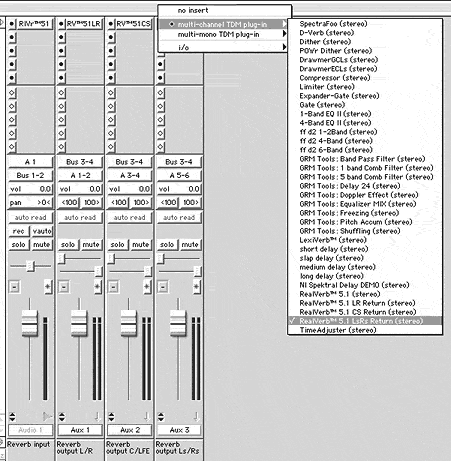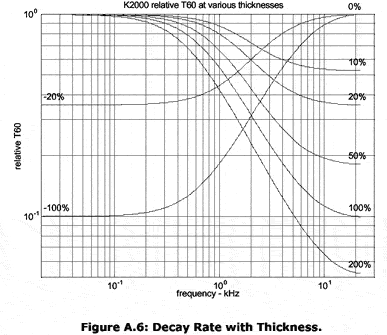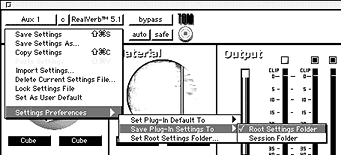
RealVerb does not use the ProTools Surround Mixer but the normal Stereo Mixer. The "RealVerb 5.1" TDM Plug-In can be inserted into a mono or stereo track or aux. This is only the input plug-in, the output of this track or aux should be routed to an unused output or bus.
The output of the reverb is accessed through three other return Plug-Ins "Real Verb 5.1 LR Return" (for left + right), " Real Verb 5.1 CS Return" (for center and subwoofer), " Real Verb 5.1 LsRs Return" (for surround left + right). These should be inserted into three distinct stereo auxes whose inputs are set to an usued bus and whose outputs are set to the appropriate 5.0 interface outputs:

Shape: Pattern of the Early Reflections (visualized in the top half of the Timing window); a hybrid interpolation between two different shapes is possible. Top slider controls size of left shape, bottom slider controls size of right shape.
Material: frequency dependant decay times of the hall tail. Thickness 100% = normal. < 100% reduces frequency dependance, >100% increases effect. No frequency dependant decay for 0% thickness, negative thickness inverts effect:

Resonance: overall frequency response of the reverb. An equalizer that is inserted after the dry path but before the reverb path:
Timing: top half shows Early Reflections, bottom half shows late Reflections (Hall tail). Distance of box toleft window margin determines initial delay to dry signal. Box height determines amplitude, Box width determines time span. For the late reflections the time span is T60, the amount of time to pass until reverb energy decreased to -60 dB. Blue scale on the right side selects amount of diffusion (top: most diffuse sound, bottom: least diffuse sound).
Direct: = Dry signal. Angle controls azimuth; for mono input, distance to center controls spatial width; for stereo input, distance controls channel separation (while the spatial width of each channel is zero): "What this means is that with a separation of 90° and azimuth of 0°, the source will appear in the left and right speakers only, and not the center. By contrast, a monophonic source panned to a width of 90° and an azimuth of 0° will appear in all front speakers."
Early + Late: dito. (azimuth / width)
Position: not to be confused with the panning of dry signal ("Direct"), this controls the distance between the sound source and the listener and therefore affects the ratio between dry and wet signal. This ratio can also be controlled with the Mix slider (left = dry, right = wet).
The meters show the signal out, the LFE output contains always silence! The slider controls input gain (not output gain!)
Morphing allows to blend between two different reverbs. When activated, the spectral characteristic parameters are disabled. Morphing can only occur between two preset reverbs chosen from the two pulldown menus in the morphing section.
To use your own settings in the morphing mode, they need to be saved as presets in the root-folder. To save your settings in the root folder, select root-folder as saving destination:

Then select "Save Settings As..." from the Plug-In´s Preset menu. The newly saved setting then appears in the pulldown menus of the morphing section.
| Materials with High Frequency Absorption |
Materials with High Frequency Reflections |
| Audience | Heavy Plate Glass |
| Cellulose | Plywood |
| Drapery | Hardwood |
| Plaster on Concrete Block | Glass Window |
| Soil | Cork |
| Gravel | Seats |
| Paint on Concrete Block | Marble |
| Carpet | Concrete Block |
| Fiberglass | Linoleum |
| Grass | |
| Plaster on Brick | |
| Water Surface | |
| Sand | |
| Brick | |
| Air (*) |
(* used to compensate for the high frequency absorption from the air of a room!)
Last modified: 02-Jul-03 H.H.Rutz